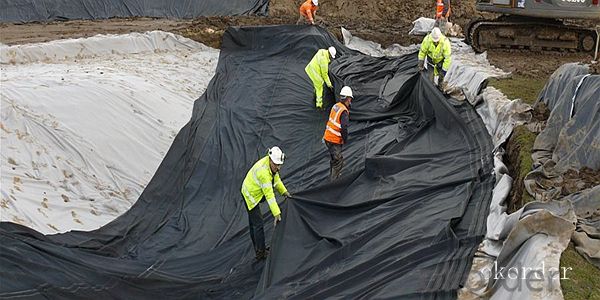- Understanding the Role of Geomembrane Liners in Waste Management
- Innovations in Geomembrane Liners for Water Management
- Geomembrane Liners: A Comprehensive Guide
- The Future of Geomembrane Liners in Civil Engineering
- Geomembrane Liners: Enhancing Landfill Stability
Manager:Alvin Wang
WhatsApp:+62 8983806051
Tel:+86 10-5797-1075
Email:steelwang@okorder.com
Address:3rd Floor, No.2 Building, No.1 Sanlihe Road
HDPE Geomembranes: The Key to Efficient Wastewater Pond Lining
Wastewater management is a critical aspect of environmental protection, and one of the most effective methods for containing and treating wastewater is through the use of hdpe Geomembranes. These versatile materials offer a range of benefits that make them an ideal choice for lining wastewater ponds. In this article, we'll explore the advantages of HDPE geomembranes, their installation process, and the role they play in creating an efficient and sustainable wastewater management system.

The Benefits of HDPE Geomembranes
HDPE, or high-density polyethylene, is a type of plastic that is highly resistant to chemicals, UV radiation, and temperature changes. This makes it an excellent material for constructing geomembranes, which are used to line ponds and other containment structures. Some of the key benefits of using HDPE geomembranes include:
- Chemical Resistance: HDPE geomembranes are incredibly resistant to a wide range of chemicals, including those found in wastewater. This ensures that the membrane remains intact and functional, even when exposed to harsh chemicals.
- Puncture Resistance: The durability of HDPE geomembranes makes them resistant to punctures and tears, which can be common in other types of liners.
- Low Permeability: HDPE has a very low permeability, ensuring that liquids and contaminants stay within the pond and do not seep into the surrounding environment.
- Longevity: HDPE geomembranes have a long lifespan, often lasting for decades with proper care and maintenance.
- Flexibility: These membranes can be easily shaped and installed to fit the contours of a pond, making them a versatile option for various pond shapes and sizes.
The Installation Process
Installing HDPE geomembranes is a carefully planned process that involves several steps to ensure a secure and leak-proof barrier. Here's a brief overview of the installation process:
1. Site Preparation: The area where the pond will be located is prepared by clearing debris, leveling the ground, and compacting the soil to create a stable base.
2. Subgrade Preparation: A smooth, even surface is created to support the geomembrane and ensure proper contact with the ground.
3. Geomembrane Installation: The HDPE geomembrane is carefully unrolled and positioned over the prepared subgrade. Special attention is given to the seams, where the sheets of geomembrane are joined together using heat welding or other approved methods to create a strong bond.
4. Seam Testing: After the seams are made, they are tested for integrity to ensure there are no leaks.
5. Final Inspection: Once the geomembrane is in place, a final inspection is conducted to confirm that it meets all the required specifications and is ready for use.
The Role of HDPE Geomembranes in Wastewater Management
HDPE geomembranes play a crucial role in the efficient management of wastewater ponds. They provide a reliable barrier that prevents the escape of contaminants into the environment, which is essential for protecting ecosystems and human health. Additionally, HDPE geomembranes contribute to the following aspects of wastewater management:
- Containment: By lining wastewater ponds with HDPE geomembranes, we can effectively contain the wastewater and prevent it from contaminating nearby water sources.
- Treatment: The geomembranes create an enclosed environment that allows for the treatment of wastewater through various methods, such as biological processes or chemical treatments.
- Regulation Compliance: Using HDPE geomembranes can help facilities meet regulatory requirements for wastewater containment and treatment, ensuring compliance with environmental standards.
- Sustainability: With their long lifespan and low maintenance requirements, HDPE geomembranes contribute to a more sustainable approach to wastewater management.
Personal Touch: The Human Element in Wastewater Management
While HDPE geomembranes are a crucial component of wastewater management, it's important to remember that the human element is equally important. Skilled professionals are needed to design, install, and maintain these systems, ensuring that they function effectively and safely. The dedication and expertise of these individuals are what truly bring these systems to life and make them an integral part of our efforts to protect the environment.
Conclusion
In conclusion, HDPE geomembranes are a key component in the creation of efficient wastewater pond lining systems. Their chemical resistance, puncture resistance, low permeability, and longevity make them an ideal choice for this application. By understanding the benefits and installation process of HDPE geomembranes, we can better appreciate their role in wastewater management and the protection of our environment. Let's continue to innovate and improve upon these technologies to ensure a cleaner and more sustainable future for all.
- Previous:HDPE Geomembranes: A Protective Layer for Industrial Ponds
- Next:HDPE Geomembranes: The Environmentally Friendly Choice for Lining
-
2024-12-05Geomembrane Liners: A Comprehensive Guide






